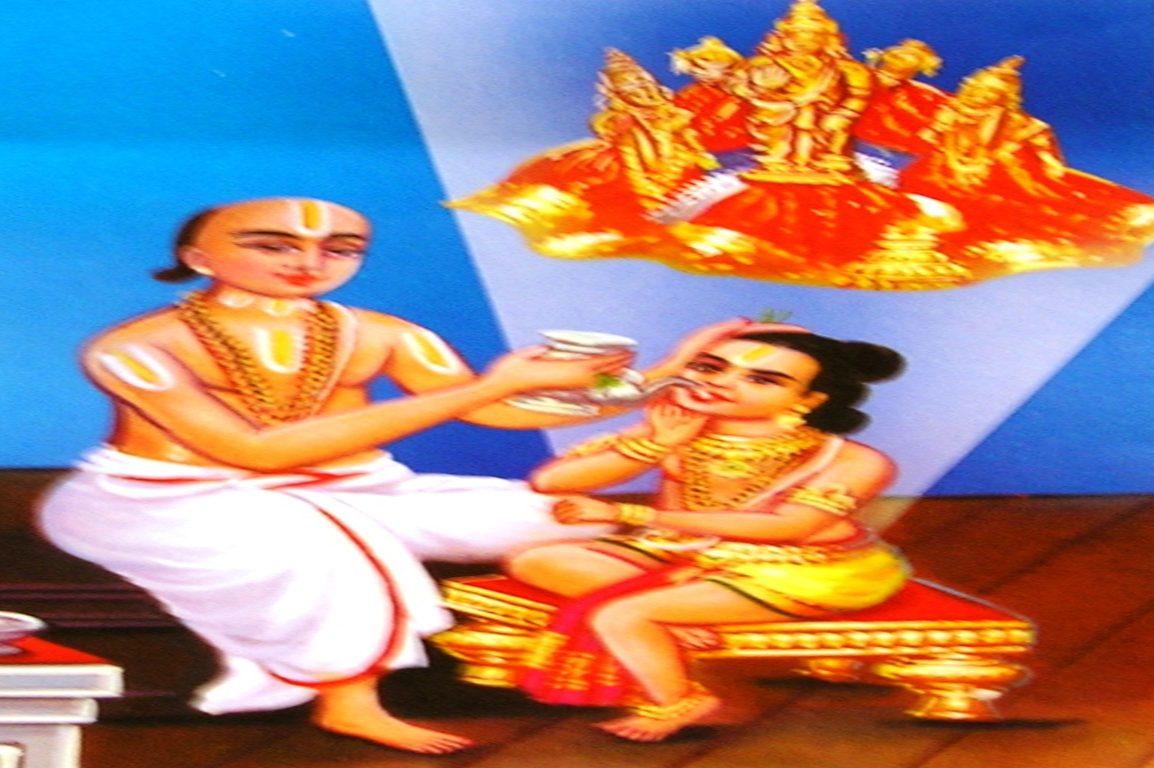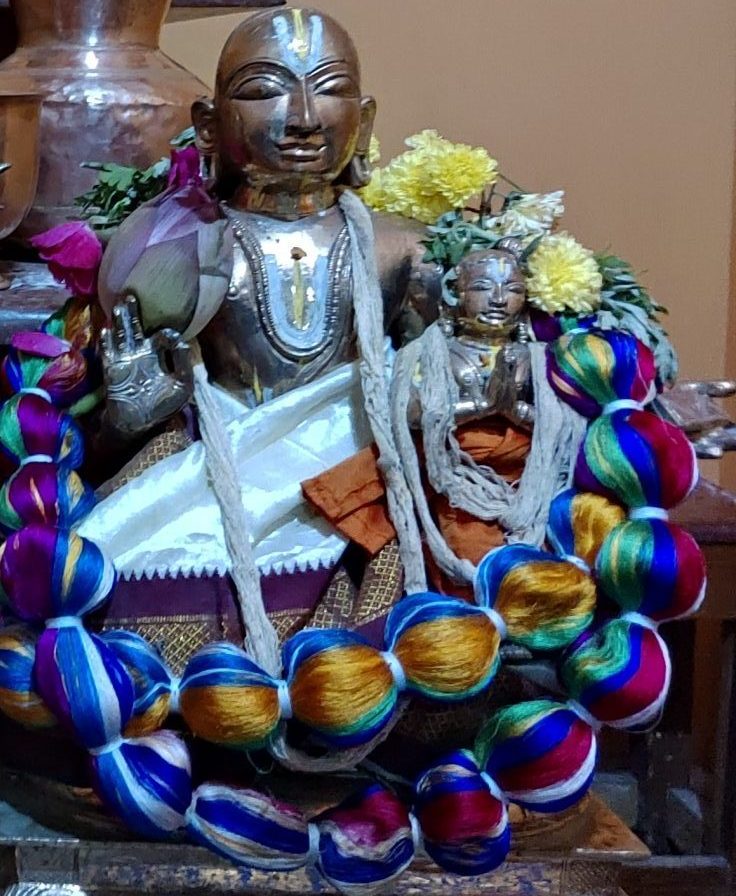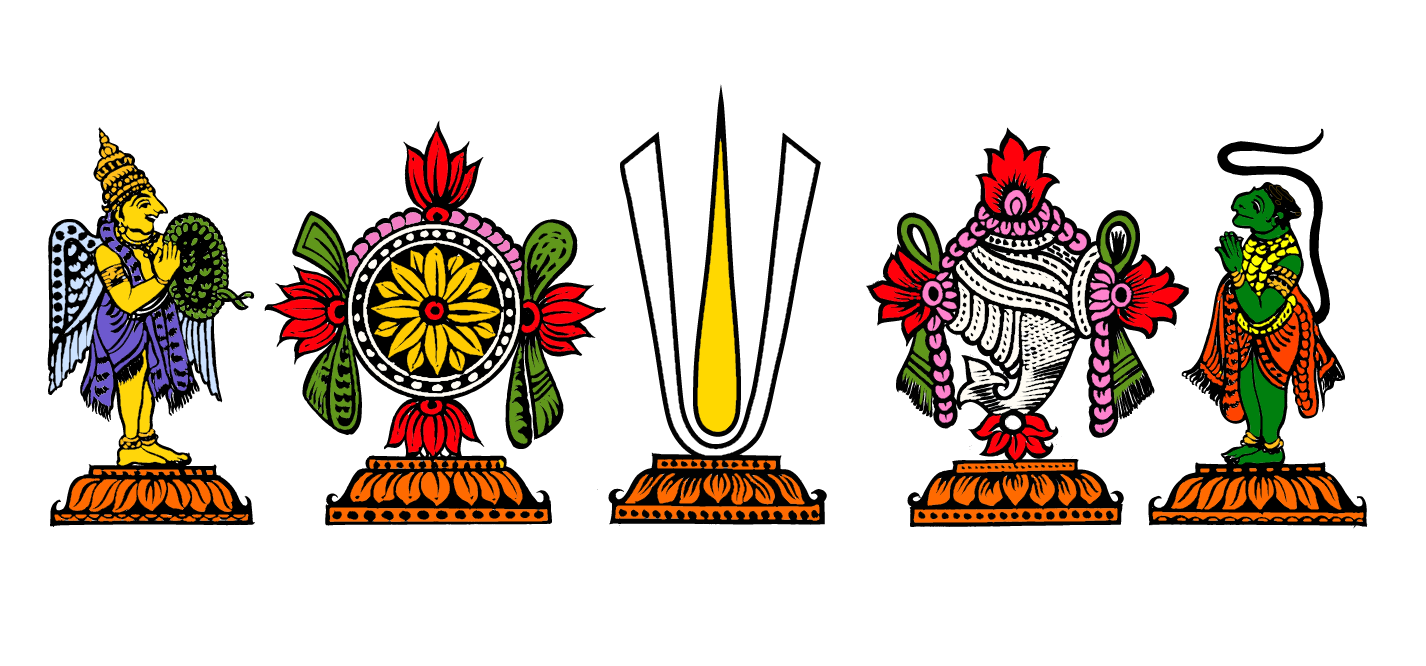Introduction
Nadadoor Ammal (1165 – 1275 A.D.) was a scion of the Nadadoor clan. As the grandson of the great Acharya Nadadoor Azhwan, he was one of the foremost scholars in Sri Vaishnava philosophy, and was deeply devoted to Lord Varadaraja. His utmost devotion towards Lord Varadaraja earned him epithet “Ammal”, when moved by his motherly affection, the Lord Himself addressed him as “Mother!”.

Nadadoor Ammal feeding Lord Vishnu in the form of Varadaraja with milk aftere ensuring that it is no longer hot
Early Life – “Ammalacharya”
Nadadoor Ammal was the son of Devaraja Mahadesikan. He was born on the full moon day of Chitra month with Chitra nakshatra. (Some researchers have come to the conclusion that he was born during 1165 A.D. the corresponding Tamil year being ‘Parthiva’). Varadaguru was well-trained by his erudite father in all faculties, and the father decided to teach Sri Bhashyam to his son. On an auspicious day Devaraja Mahadesikan commenced the teaching with the invocation of the song which began with the words ‘Akhila Bhuvana’. The young Varadaguru stopped his father with a question, ‘Why should Emperumaanar choose the word ‘Akhila’ instead of words like ‘sakala ‘nikhila’, when all of them denote the same meaning? The happy and surprised father, however, answered his son that Udayavar’s choice of word was to begin his magnum opus with the first alphabet representing Lord Narayana Devaraja, at the same time knew well that he being old did not have enough strength to appease the intellectual hunger of his boy. So he decided to send him to Engal Azhwan of Thiruvellarai. Engal Azhwan, called so by Ramanuja himself, had helped Nadadoor Azhwan in scribing the work as Koorathazhwan had become blind. Engal Azhwan had a good training under Thirukkurukaippiran Pillan and had retired to Thiruvellarai to spend his life in solitude.
An interesting episode between the master and disciple is illuminating. At Thiruvellarai, Varadaguru found out Engal Azhwan’s residence and tapped at the door. The teacher asked “Who is that?” The student replied, “I am Varadan, Kanchi Nadadoor Devaraja Mahadesikan’s son.” The teacher replied,” Whoever it is come after “I”die. The perplexed Varadan returned home and asked his father. The father explained that the word “I” denotes ego or ahamkara and the teacher had only asked him to shed off his ego and then approach him. Moreover according to Srivaishnava tradition, there is no “I” or “me”, there is only the beautiful word ‘adiyen’.Varadan realized his mistake and prostrated before Engal Azhwan who adopted him not only as disciple but also as his beloved son. Both of them traveled together, worshipped the arca forms in the temples and finally reached a small hamlet Kollagonda, near Srivilliputtur. Engal Azhwan wrote a commentary to ‘Vishnu Puranam’ and in course of time reached his heavenly abode. As an obedient son, Varadasuri performed all funeral rites and at Thiruvellarai installed the arca form of his Acharya.It can be seen in this image form, Varadaguru is seated at the feet of his master. He has also shown his deep Acharya Bhakti in the dhyana sloka of his work Tattvasara. Varadaguru gave the responsibility of looking after the arca forms at Thiruvellarai to Engal Azhwan’s daughter’s family. Later they came to be known as ‘Ammalacharyas’. Having done his duty to his guru, Varadaguru returned to Kanchipuram.
Varadaguru’s Kalakshepas, Pilgrimages & Debates
At Kanchi, Varadaguru began his Sri Bhashya teaching near ‘Kachi vayththan Mantapam’ the eastern side of the temple sanctum sanctorum. He chose this spot because this was the place where the Lord Himself sowed the seeds of Sri Bhashya, as answers to the six questions postulated by Sri Ramanuja by Thirukachchi Nambigal.
Varadaguru made several pilgrimages. He won in debate against many, including Sivasular, a Saivite at Sethu, Ananda Madhavacharya at the court of the Chola king, and the fanatic Kumbisutan before the king of Kasi. The Kashi king honoured him by placing him on the Sharada Peeth. Varadaguru composed ‘Hetirajastavam’ and saved a possessed Brahmin. After his pilgrimage, he returned to Kanchi and continued his Sri Bhashya Upanyasa. His sweet rendering and excellent discourse attracted many disciples like Appullar alias Atreya Ramanuja, Vadakku Thiruveethipillai, and Sudarshana Suri, the great grandson of KoorathAzhwan.
Once, Ammal and his disciples undertook a pilgrimage to Tirumalai hills. Their graceful personality and behavior attracted all. Kandavaran, the leader of the Lada race was annoyed and irritated to see them. He decided to disturb them. With his mantric power he made the disciples unconscious. Ammal meditated and chanted the Sudarsana mantra and his own composition ‘Hetipungavastotram’ and broke the spell. The angry Kandavaran called Ammal for a debate and when defeated surrendered to the Acharya himself. The benevolent guru not only excused him but also made him a Srivaishnava by offering him Panchasamskaras.With the money offered by Kandavaran, Ammal established a beautiful village and named it ‘Ladagraharam’. Then he continued his journey. On the way, the Lord himself came as a young Brahmachari and appeased the hunger of the pilgrims with curd and rice. At the same time, there was a big commotion in the temple as the silver vessel with the naivedyam had suddenly disappeared. Lord Venkateswara Himself announced to the temple authorities that He Himself fed his dear Ammal and his disciples and that they should receive Ammal with all temple honours.
How Varadaguru became Nadadoor Ammal
Varadaguru had the deepest Bhakti to Lord Varadaraja. One night, when he was worshipping the deity in an ecstatic mood, the priest brought very hot milk to the Lord as Nivedana. Varadaguru was deeply distressed that such hot milk would burn the tender tongue of the Lord! He stopped the priest from offering the hot milk and began cooling it down until it was warm enough to be drunk. The Lord himself was moved by the Vatsalya of Varada and called him ‘Amma!’, which means ‘mother’ in Tamil. From then onwards Varadaguru became Nadadoor Ammal. After this episode, in a dream one night, Lord Varadaraja commanded Ammal to erect a Mantapam for His Vasantotsavam. Accordingly Ammal fulfilled the Lord’s desire, just as a mother would fulfill the wishes of her son in spite of difficulties.
Shrutaprakashika
Shrutaprakashika is the most detailed commentary on Sri Ramanuja’s magnum opus, ‘Sri Bhashya’. It got its name from the fact that Sudarshana Suri compiled it by listening to the Kalakshepa lectures delivered by Nadadoor Ammal and scribing the contents of the discourses.
There is an interesting story about Nadadoor Ammal and Sudarshana Suri. The students of Nadadoor Ammal used to listen to his lecture attentively and by their pertinent questions, now and then got clarification from their learned master. But Sudarshana Suri alone would remain quiet; he had no questions to ask. His mates discarded him as dud. One day, as usual, the students had assembled in the lecture hall. But the teacher was not willing to begin the lecture since Sudarshana Suri had not turned up. The other students compelled the master to begin the discourse saying that the presence or absence of the stone like Sudarshana Suri during the discourse was one and the same. The master regretted to hear these words and knowing Sudarshana Suri’s deep scholarship, decided to prove it to the class. During the course of the lecture, the Acharya asked Sudarshana Suri to explain a simple phrase. To everyone’s surprise, Sudarshana Suri not only gave the literal meaning but also the in depth meanings given by his master in the previous occasion. The teacher himself did not expect this. Sudarshana Suri explained that he had a habit of scribing the content of the discourse every night on palm leaves and presented the script to Varadaguru. This came to be known as Shrutaprakashika. Later, Sudarshana Bhattar elaborated it and completed it in 36,000 granthas.
In its survival, Shrutaprakashika saw many vicissitudes in the national scene, including the invasion of Malik Kafur. Sri Swami Desikan did a remarkable service to protect the script by feigning death and lying like a dead man among corpses. It is to be noted that Swami Vedanta Desika’s Acharya, Appullar (Atreya Ramanuja), was himself a disciple of Nadadoor Ammal. Sri Nadadoor Ammal blessing the five year old Swami Desikan at the eastern prakaara of Sri Varadaraja Temple is a celebrated event in the history of Sri Vaishnavism. A depiction of this event can be seen even today in a roof painting at the very same location. Devout Sri Vaishanavas make it a point to pay obeisance at this place before having the darshan of Lord Sri Varadaraja.
Nadadoor Ammal blesses Swami Vedanta Desikan

Nadadoor Ammal continued his Sri Bhashya Pravachana even at the ripe old age of hundred. Once, one of his disciples, Atreya Ramanuja (better known as Appullar), had gone to visit his sister Totaramba at Thooppul. When he returned to Kanchi, his five year old nephew, Venkatanatha also accompanied him. As soon as they reached Kanchi, Appullar went to see his beloved teacher.
At that time, Nadadoor Ammal was lecturing on Sri Bhashyam referring to a portion there on the importance of Vishnu Puranam. He was explaining the greatness of its author, sage Parashara, by explicating the opening phrase of a hymn, ‘Patayi Parasarasatam’. Varadaguru stopped his discourse abruptly when Appullar and his nephew prostrated before him – he was attracted by the Brahmavarchas of the child. On enquiry, Appullar told him that the child was born after his sister’s pilgrimage to Thirumalai hills, when she dreamt of swallowing the big bell of the temple. No wonder the child had a divine look! Ammal blessed the child and tried to pick up the discourse from where it stopped. But he could not remember the link, nor could anyone present guide him. To everybody’s surprise, little Venkatanatha prattled the Prakrit phrase and thus reminded the Acharya where he had stopped. Ammal’s joy knew no bounds, as he understood that the child was an incarnation. He blessed the divine child Venkatanatha with all his heart that the child would grow up to establish the Vedanta creed and be a terror to the heretics and their false arguments. Since he was very old, he asked his disciple Appullar to be Venkatanatha’s guru and teach him Shri Bhashya.
That Nadadoor Ammal’s grace alone had made the ordinary Venkatanatha into Vedanta Desika has been repeatedly stated by Sri Swami Desikan himself in his works like Adhikarana Saravali, Tattva mukta kalaapam, Nyaya Sidhdhanjanam and Tatvatika. The same sloka with which Ammal blessed Swami Desikan has been included by Sri Desikan in his Sankalpa Suryodayam. Sri Desikan’s son also has recorded in the Mangalashasanam of his father about this benediction of Nadadoor Ammal.
Works of Nadadoor Ammal
Varadaguru was a great Bhaktiman who got the title ‘Ammal’ from the Lord himself. At the same time, Ammal’s scholarly contributions should not be forgotten.
Apart from narrating what later became Shrutaprakashika, Nadadoor Ammal has created the following nineteen works:
1. Tattvasaram
2. Prapanna Parijatam
3. Prameyamala
4. Annika Choodamani
5. Aradhana kramam
6. Prameya Saram
7. Mangalashasanam
8. Jnana Saram
9. Jayanti Niroopanam
10. Hetiraja Stavam
11. Rahasya Sangraham
12. Chaturlakshana Sangraham
13. Paratattva Nirnayam
14. Dramidopanishad Sangraham
15. Sri Bhashya Sangraham
16. Prataranusadeya Shlokas
17. Paramartha Shlokadvayam
18. Paratvadi Panchakam
19. Yatilinga Samarthanam
Ammal and After
After a long life of one hundred and ten years, Nadadoor Ammal departed to Paramapada on the Shuklapaksha Panchami of the Tamil Masi month in Yuva year (1275 A.D.).
Ammal had four sons – Sri Varadavishnu, Sri Devaraja, Sri Sudarshanar and Sri Hethisa.
The biography of Sri Nadadoor Ammal has been complied from two works, Varadadeshikabhyudayam and Varadadeshika Vaibhava Prakasika. The author of these two works, Mimamsa Vallabha, says that the former Kavya with eight sargas is an abridged form of Acharya Deepam of Hemamali Desika. Both the authors were descendents of Nadadoor Ammal. Mimamsa Vallabhar composed nine works on Nadadoor Ammal alone:
1. Varadadeshika Suprabhatam
2. Varadadeshika Dandakam
3. Varadadeshika Gadyam
4. Varadadeshika Panchashat
5. Varadadeshika Ashtotra Shatanama Stotram
6. Varadadeshika Vaibhava Prakasika
7. Varadadeshika Sambhavana kramam
8. Varadadeshika Prabhava deepam
9. Varadadeshikabhyudayam
